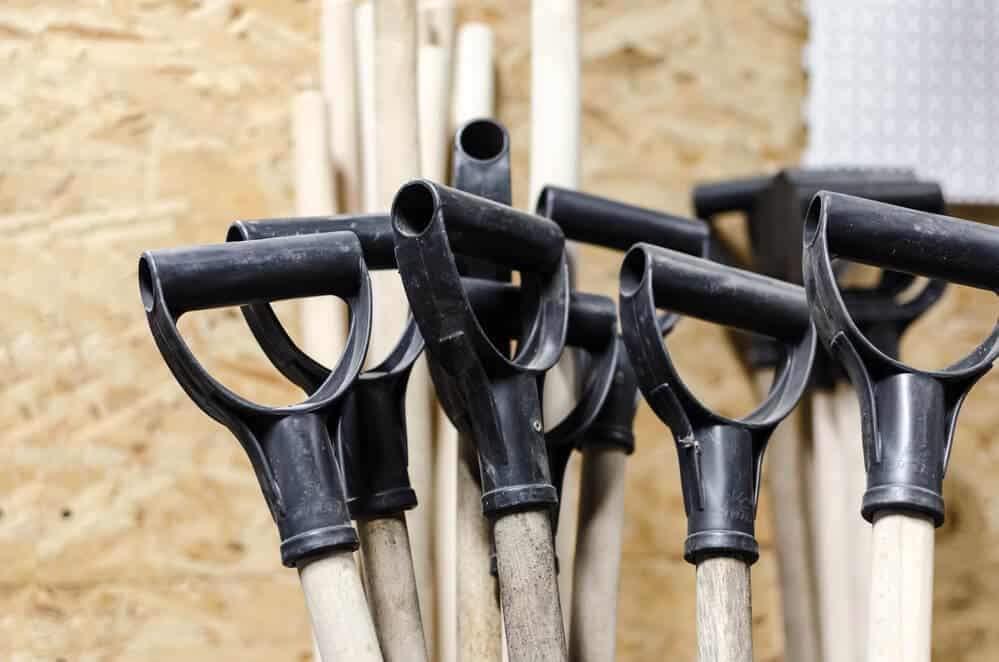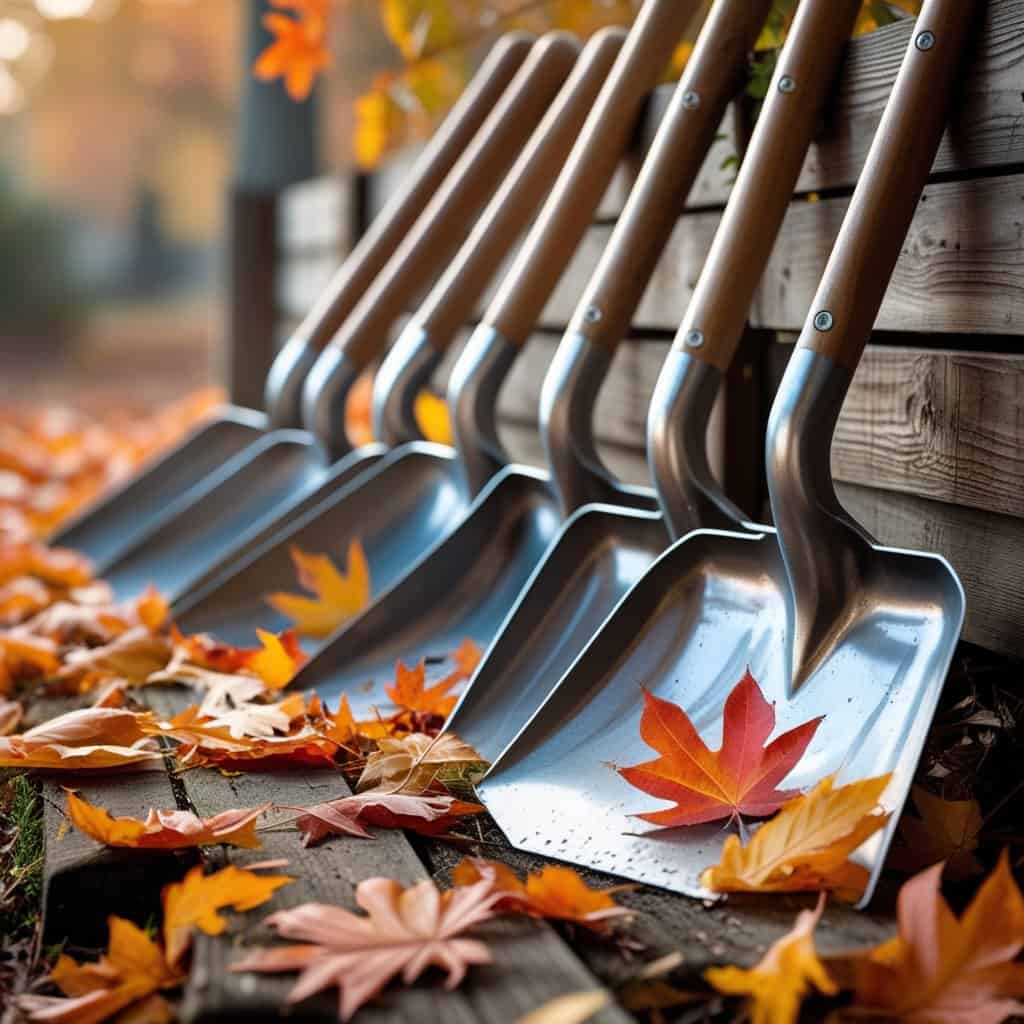Different types of shovel handles are available on shovels, and each has its own set of benefits. The most common shovel handle types are wooden, metal or aluminum, plastic, and fiberglass.
Table of Contents
Types Of Shovel Handles
When choosing a shovel handle, consider the task and type of shovel. For example, a wooden or plastic shovel handle may be sufficient for light-duty shoveling tasks such as removing snow. However, the strength of a plastic shovel would not meet the demands of digging in clay or rocks and will fail, so a metal or fiberglass shovel handle would be better for heavy-duty shoveling tasks. A wooden handle will also work in heavy-duty tasks, but it will require more care than a metal or fiberglass one as it will dry out and crack or break over time.
Another factor for your consideration is the climate in which you will use the shovel. A metal or fiberglass shovel handle is the best choice for shovels used in extreme weather conditions.
Let’s look at each handle type for you to choose the best shovel handle to meet your needs, with the pros and cons of each:
1. Wood handles
Wooden shovel handles are the most traditional type of shovel handle, and they offer many benefits.
| PROS | CONS |
| a. Sturdy and durable | a. Not water resistant |
| b. Offers good grip and comfort | b. Requires care and manintenance for longevity |
| c. Relativley inexpensive | c. Heavier than other handle materials |
| d. Uncomfortable when using for long periods |
2. Metal Handles
Metal shovel handles are a more modern option making them ideal for heavy-duty shoveling tasks.
| PROS | CONS |
| a. Lightweight and durable | a. More expensive than other types of handles |
| b. Withstand exreme weather conditions; hot or cold temps. | |
| c. Durability is greater than wood handles | |
| d. Easy to maintain and clean |
3. Plastic Handles
Plastic shovel handles are the most lightweight and offer the best resistance to weathering as well as being affordable.
| PROS | CONS |
| a. Lightweight | a. Less durable than other handles |
| b. Great grip | b. Plastic can weather and dry out over time |
| c. More affordabel than other handles | c. Cracks easily if overburdened |
4. Fiberglass Handles
Lastly is the fiberglass shovel handle, a combination of metal and plastic shovel handles. This type of handle offers the best of both worlds in terms of durability, comfort, and weather resistance and is a great investment if you do a lot of shoveling.
| PROS | CONS |
| a. Lightweight | a. More expensive than other handles |
| b. Comfortable grip | |
| c. Durable | |
| d. Strong | |
| e. Good weather resistance | |
| f. Easy to care for |
Design Of The Shovel Handle
What the handle is made from is an important consideration as is the design of the handle. There are five handle designs that can be chosen.
1. Straight Shovel Handles
Straight shovel handles are the most common handle found on a shovel, and they are most often made from wood or metal. They offer good stability and are easy to use but can be uncomfortable when digging for extended periods.
2. Ergonomic shovel handles
3. Telescoping shovel handles
These shovel handles extend and lock into place, allowing you to adjust the length to suit your height and reach. They are perfect for shoveling in tight spaces, storing an emergency shovel in your backpack or car, and using the same shovel for people of different heights. However, ensure that the handle is made from metal and that the telescoping function is secure when extended to avoid injury.
4. Folding shovel handles
A folding shovel handle is what it says; it folds down for easy storage and transportation. As these shovels fold, they are made from metal or plastic, and many you can also adjust the handle to different lengths on some models.
5. Collapsible shovel handles
A collapsible shovel handle is different from a telescoping handle in that these handles may detach or fold away. However, as they collapse to a tiny size, they are easily stored in a toolbox or glove compartment. These handles are typically made from metal or plastic and come in various lengths.
Best Shovel Handle Lengths
The best length for your shovel handle is based on your height, and the depth of the substrate you work with. For instance, if you are shoveling a foot of snow, you will need a longer shovel handle to reach the bottom of the snow pile. Likewise, you may need a longer shovel handle to avoid stooping over while shoveling if you are tall.
Shorter shovel handles are easier to maneuver, while longer shovel handles provide more leverage.
Choosing the correct shovel handle is essential for comfort and efficiency while shoveling. Consider the type of material, the length, and the adjustability of the shovel handle before making your purchase. Whether you are shoveling snow, clearing debris, or moving gravel, a quality shovel handle can make a difference. Our guide Choosing The Best Shovel For You is also an excellent resource.
Tips For The Correct Shovel Handle Length
- If you are 5 feet tall or shorter, a shovel handle between 2 and 4 feet long will work best for you. A two to four-foot handle will offer good maneuverability in tight spaces and when shoveling shallow depths.
- If you are 5 to 6 feet tall, a shovel handle between 4 and 6 feet long will work best for you. This handle will offer a good balance of reach and maneuverability and work well in most shoveling situations.
- If you are 6 feet tall or taller, a shovel handle between 6 and 8 feet long will work best for you. You will get a good reach with a six to eight-foot-long handle, which is ideal for shoveling deeper snow depths and clearing debris in larger areas.
Choosing the right shovel handle length is important for comfort and efficiency while shoveling. Be sure to consider your height and the depth of the substrate before making your purchase. Whether you are shoveling snow, clearing debris, or moving heavy items, a quality shovel handle can make a difference.
Handle Ends – D ring, T shaped, Straight
An integral component of a shovel handle is the handle end. There are three handle ends; D ring, T shaped, and Straight.
D Ring
D-rings are ideal for heavy-duty shoveling and chopping tasks, as they offer good leverage and support. However, the D ring shovel handle end may be too large and cumbersome for those with smaller hands, and they may not provide the same level of control as other styles. A D-style ring is considered to be ergonomic in most situations.

T Shaped
T-handle ends are a good choice for smaller shoveling tasks, as they offer better control and maneuverability. They are ideal when lining up your shovel to cut a straight or angled edge or trench. However, they are not suitable for heavy-duty shoveling or moving large amounts of debris or materials. In addition, the handle end will not provide enough leverage or support to lift and transport materials, making the task more tiring and challenging for you.

Straight Handle
Straight handle end shovels are a versatile option used for most shoveling tasks. This handle end offers good reach and leverage and is available in various lengths to accommodate different users. However, straight-handle ends may not be as comfortable for some.

Final Thoughts
Choosing a suitable shovel handle is important for comfort and efficiency while shoveling. Consider the type of material, the length, your height, and the shovel handle’s adjustability.











